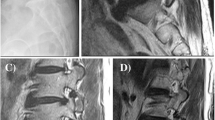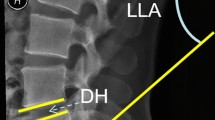Abstract
Purpose
To evaluate the incidence and course of iatrogenic L5 radiculopathy after reduction and instrumented fusion of high-grade L5–S1 isthmic spondylolisthesis and the role of intraoperative neurophysiological monitoring (IONM).
Methods
Consecutive patients treated for high-grade spondylolisthesis with IONM from 2005 to 2013 were screened for eligibility. Prospectively collected clinical and surgical data as well as radiographic outcomes were analyzed retrospectively. Patients completed the multidimensional Core Outcome Measures Index (COMI) before and at 3, 12, and 24 months after surgery.
Results
Seventeen patients were included, with a mean age of 26.3 (±9.5) years. Mean preoperative L5–S1 slip was 72% (±21%) and was reduced to 19% (±13%) postoperatively. Mean loss of reduction at last follow-up [mean 19 months (±14, range 3–48 months)] was 3% (±4.3%). Rate of new L5 radiculopathy with motor deficit (L5MD) after surgery was 29% (five patients). Four patients fully recovered after 3 months, one patient was lost to neurologic follow-up. IONM sensitivity and specificity for postoperative L5MD was 20 and 100%, respectively. COMI, back pain and leg pain scores showed significant (p < 0.001) improvements at 3 months postoperatively, which were retained up to 24 months postoperatively.
Conclusions
Transient L5 radiculopathy after reduction and instrumented fusion of high-grade spondylolisthesis is frequent. With IONM the risk of irreversible L5 radiculopathy is minimal. If IONM signal changes recover, full clinical recovery is expected within 3 months. Overall, patient-reported outcome of reduction and instrumented fusion of high-grade spondylolisthesis showed clinically important improvement.



Similar content being viewed by others
References
Moller H, Hedlund R (2000) Surgery versus conservative management in adult isthmic spondylolisthesis—a prospective randomized study: part 1. Spine 25:1711–1715
Helenius I, Lamberg T, Osterman K, Schlenzka D, Yrjonen T, Tervahartiala P, Seitsalo S, Poussa M, Remes V (2006) Posterolateral, anterior, or circumferential fusion in situ for high-grade spondylolisthesis in young patients: a long-term evaluation using the Scoliosis Research Society questionnaire. Spine 31:190–196
Poussa M, Schlenzka D, Seitsalo S, Ylikoski M, Hurri H, Osterman K (1993) Surgical treatment of severe isthmic spondylolisthesis in adolescents. Reduction or fusion in situ. Spine 18:894–901
Poussa M, Remes V, Lamberg T, Tervahartiala P, Schlenzka D, Yrjonen T, Osterman K, Seitsalo S, Helenius I (2006) Treatment of severe spondylolisthesis in adolescence with reduction or fusion in situ: long-term clinical, radiologic, and functional outcome. Spine 31:583–590. doi:10.1097/01.brs.0000201401.17944.f7 (discussion 591–582)
Tiusanen H, Schlenzka D, Seitsalo S, Poussa M, Osterman K (1996) Results of a trial of anterior or circumferential lumbar fusion in the treatment of severe isthmic spondylolisthesis in young patients. J Pediatr Orthop B 5:190–194
Grzegorzewski A, Kumar SJ (2000) In situ posterolateral spine arthrodesis for grades III, IV, and V spondylolisthesis in children and adolescents. J Pediatr Orthop 20:506–511
Ishikawa S, Kumar SJ, Torres BC (1994) Surgical treatment of dysplastic spondylolisthesis. Results after in situ fusion. Spine 19:1691–1696
Lance EM (1966) Treatment of severe spondylolisthesis with neural involvement. A report of two cases. J Bone Jt Surg Am 48:883–891
Lenke LG, Bridwell KH, Bullis D, Betz RR, Baldus C, Schoenecker PL (1992) Results of in situ fusion for isthmic spondylolisthesis. J Spinal Disord 5:433–442
Remes V, Lamberg T, Tervahartiala P, Helenius I, Schlenzka D, Yrjonen T, Osterman K, Seitsalo S, Poussa M (2006) Long-term outcome after posterolateral, anterior, and circumferential fusion for high-grade isthmic spondylolisthesis in children and adolescents: magnetic resonance imaging findings after average of 17-year follow-up. Spine 31:2491–2499. doi:10.1097/01.brs.0000239218.38489.db
Seitsalo S, Osterman K, Hyvarinen H, Schlenzka D, Poussa M (1990) Severe spondylolisthesis in children and adolescents. A long-term review of fusion in situ. J Bone Jt Surg Br 72:259–265
Wiltse LL, Jackson DW (1976) Treatment of spondylolisthesis and spondylolysis in children. Clin Orthop Relat Res 117:92–100
Lamberg T, Remes V, Helenius I, Schlenzka D, Seitsalo S, Poussa M (2007) Uninstrumented in situ fusion for high-grade childhood and adolescent isthmic spondylolisthesis: long-term outcome. J Bone Jt Surg Am 89:512–518. doi:10.2106/JBJS.E.00545
Dick WT, Schnebel B (1988) Severe spondylolisthesis. Reduction and internal fixation. Clin Orthop Relat Res 232:70–79
Matthiass HH, Heine J (1986) The surgical reduction of spondylolisthesis. Clin Orthop Relat Res 203:34–44
Molinari RW, Bridwell KH, Lenke LG, Ungacta FF, Riew KD (1999) Complications in the surgical treatment of pediatric high-grade, isthmic dysplastic spondylolisthesis. A comparison of three surgical approaches. Spine 24:1701–1711
Muschik M, Zippel H, Perka C (1997) Surgical management of severe spondylolisthesis in children and adolescents. Anterior fusion in situ versus anterior spondylodesis with posterior transpedicular instrumentation and reduction. Spine 22:2036–2042 (discussion 2043)
Ruf M, Koch H, Melcher RP, Harms J (2006) Anatomic reduction and monosegmental fusion in high-grade developmental spondylolisthesis. Spine 31:269–274. doi:10.1097/01.brs.0000197204.91891.eb
Sailhan F, Gollogly S, Roussouly P (2006) The radiographic results and neurologic complications of instrumented reduction and fusion of high-grade spondylolisthesis without decompression of the neural elements: a retrospective review of 44 patients. Spine 31:161–169 (discussion 170)
Passias PG, Poorman CE, Yang S, Boniello AJ, Jalai CM, Worley N, Lafage V (2015) Surgical treatment strategies for high-grade spondylolisthesis: a systematic review. Int J Spine Surg 9:50. doi:10.14444/2050
Cheung EV, Herman MJ, Cavalier R, Pizzutillo PD (2006) Spondylolysis and spondylolisthesis in children and adolescents: II. Surgical management. J Am Acad Orthop Surg 14:488–498
Bradford DS, Gotfried Y (1987) Staged salvage reconstruction of grade-IV and V spondylolisthesis. J Bone Jt Surg Am 69:191–202
Ani N, Keppler L, Biscup RS, Steffee AD (1991) Reduction of high-grade slips (grades III–V) with VSP instrumentation. Report of a series of 41 cases. Spine 16:S302–S310
Vialle R, Charosky S, Padovani JP, Rigault P, Glorion C (2006) Surgical treatment of high-grade lumbosacral spondylolisthesis in childhood, adolescent and young adult by the “double-plate” technique: a past experience. Eur Spine J 15:1210–1218. doi:10.1007/s00586-005-0051-2
Kasliwal MK, Smith JS, Shaffrey CI, Saulle D, Lenke LG, Polly DW Jr, Ames CP, Perra JH (2012) Short-term complications associated with surgery for high-grade spondylolisthesis in adults and pediatric patients: a report from the scoliosis research society morbidity and mortality database. Neurosurgery 71:109–116. doi:10.1227/NEU.0b013e3182535881
DeWald CJ, Vartabedian JE, Rodts MF, Hammerberg KW (2005) Evaluation and management of high-grade spondylolisthesis in adults. Spine 30:S49–S59
Dvorak J, Sutter M, Eggspuehler A, Szpalski M, Aebi M (2007) Multimodal intraoperative monitoring: towards a routine use in surgical treatment of severe spinal disorders. Eur Spine J 16(Suppl 2):S113–S114. doi:10.1007/s00586-007-0415-x
Eggspuehler A, Sutter MA, Grob D, Jeszenszky D, Dvorak J (2007) Multimodal intraoperative monitoring during surgery of spinal deformities in 217 patients. Eur Spine J 16(Suppl 2):S188–S196. doi:10.1007/s00586-007-0427-6
Sutter M, Deletis V, Dvorak J, Eggspuehler A, Grob D, Macdonald D, Mueller A, Sala F, Tamaki T (2007) Current opinions and recommendations on multimodal intraoperative monitoring during spine surgeries. Eur Spine J 16(Suppl 2):S232–S237. doi:10.1007/s00586-007-0421-z
Meyerding HW (1932) Spondylolisthesis. Surg Gynecol Obstet 54:371–377
Roder C, Chavanne A, Mannion AF, Grob D, Aebi M (2005) SSE Spine Tango—content, workflow, set-up. Tango. Eur Spine J 14:920–924. http://www.eurospine.org-Spine. doi:10.1007/s00586-005-1023-2
Mannion AF, Porchet F, Kleinstuck FS, Lattig F, Jeszenszky D, Bartanusz V, Dvorak J, Grob D (2009) The quality of spine surgery from the patient’s perspective. Part 1: the Core Outcome Measures Index in clinical practice. Eur Spine J 18(Suppl 3):367–373. doi:10.1007/s00586-009-0942-8
Mannion AF, Elfering A, Staerkle R, Junge A, Grob D, Semmer NK, Jacobshagen N, Dvorak J, Boos N (2005) Outcome assessment in low back pain: how low can you go? Eur Spine J 14:1014–1026. doi:10.1007/s00586-005-0911-9
Sutter M, Eggspuehler A, Muller A, Dvorak J (2007) Multimodal intraoperative monitoring: an overview and proposal of methodology based on 1,017 cases. Eur Spine J 16(Suppl 2):S153–S161. doi:10.1007/s00586-007-0417-8
Harms J, Rolinger H (1982) A one-stager procedure in operative treatment of spondylolistheses: dorsal traction-reposition and anterior fusion (author’s transl). Z Orthop Ihre Grenzgeb 120:343–347. doi:10.1055/s-2008-1051624
Medical Research Council (1981) Aids to the examination of the Peripheral Nervous System. Her Majesty’s Stationery Office, London, England
Longo UG, Loppini M, Romeo G, Maffulli N, Denaro V (2014) Evidence-based surgical management of spondylolisthesis: reduction or arthrodesis in situ. J Bone Jt Surg Am 96:53–58. doi:10.2106/JBJS.L.01012
Seitsalo S (1990) Operative and conservative treatment of moderate spondylolisthesis in young patients. J Bone Jt Surg Br 72:908–913
Transfeldt EE, Dendrinos GK, Bradford DS (1989) Paresis of proximal lumbar roots after reduction of L5-S1 spondylolisthesis. Spine 14:884–887
Petraco DM, Spivak JM, Cappadona JG, Kummer FJ, Neuwirth MG (1996) An anatomic evaluation of L5 nerve stretch in spondylolisthesis reduction. Spine 21:1133–1138 (discussion 1139)
Hagenmaier HS, Delawi D, Verschoor N, Oner F, van Susante JL (2013) No correlation between slip reduction in low-grade spondylolisthesis or change in neuroforaminal morphology and clinical outcome. BMC Musculoskelet Disord 14:245. doi:10.1186/1471-2474-14-245
Burkus JK, Lonstein JE, Winter RB, Denis F (1992) Long-term evaluation of adolescents treated operatively for spondylolisthesis. A comparison of in situ arthrodesis only with in situ arthrodesis and reduction followed by immobilization in a cast. J Bone Jt Surg Am 74:693–704
Yang EZ, Xu JG, Liu XK, Jin GY, Xiao W, Zeng BF, Lian XF (2016) An RCT study comparing the clinical and radiological outcomes with the use of PLIF or TLIF after instrumented reduction in adult isthmic spondylolisthesis. Eur Spine J 25:1587–1594. doi:10.1007/s00586-015-4341-z
Kothbauer KF, Deletis V, Epstein FJ (1998) Motor-evoked potential monitoring for intramedullary spinal cord tumor surgery: correlation of clinical and neurophysiological data in a series of 100 consecutive procedures. Neurosurg Focus 4:e1
Nakamae T, Tanaka N, Nakanishi K, Kamei N, Hamasaki T, Izumi B, Fujioka Y, Ohta R, Ochi M (2013) Surgical treatment of high-grade dysplastic spondylolisthesis using intraoperative electrophysiological monitoring: report of two cases and review of the literature. Eur J Orthop Surg Traumatol 23(Suppl 1):S121–S127. doi:10.1007/s00590-013-1199-9
Langeloo DD, Lelivelt A, Louis Journee H, Slappendel R, de Kleuver M (2003) Transcranial electrical motor-evoked potential monitoring during surgery for spinal deformity: a study of 145 patients. Spine 28:1043–1050. doi:10.1097/01.BRS.0000061995.75709.78
Park P, Wang AC, Sangala JR, Kim SM, Hervey-Jumper S, Than KD, Farokhrani A, Lamarca F (2011) Impact of multimodal intraoperative monitoring during correction of symptomatic cervical or cervicothoracic kyphosis. J Neurosurg Spine 14:99–105. doi:10.3171/2010.9.SPINE1085
Kobayashi S, Matsuyama Y, Shinomiya K, Kawabata S, Ando M, Kanchiku T, Saito T, Takahashi M, Ito Z, Muramoto A, Fujiwara Y, Kida K, Yamada K, Wada K, Yamamoto N, Satomi K, Tani T (2014) A new alarm point of transcranial electrical stimulation motor evoked potentials for intraoperative spinal cord monitoring: a prospective multicenter study from the Spinal Cord Monitoring Working Group of the Japanese Society for Spine Surgery and Related Research. J Neurosurg Spine 20:102–107. doi:10.3171/2013.10.SPINE12944
Author information
Authors and Affiliations
Corresponding author
Ethics declarations
Conflict of interest
The authors report no conflict of interest concerning the materials and methods used in this study or the findings specified in this paper.
Rights and permissions
About this article
Cite this article
Schär, R.T., Sutter, M., Mannion, A.F. et al. Outcome of L5 radiculopathy after reduction and instrumented transforaminal lumbar interbody fusion of high-grade L5–S1 isthmic spondylolisthesis and the role of intraoperative neurophysiological monitoring. Eur Spine J 26, 679–690 (2017). https://doi.org/10.1007/s00586-017-4964-3
Received:
Revised:
Accepted:
Published:
Issue Date:
DOI: https://doi.org/10.1007/s00586-017-4964-3




